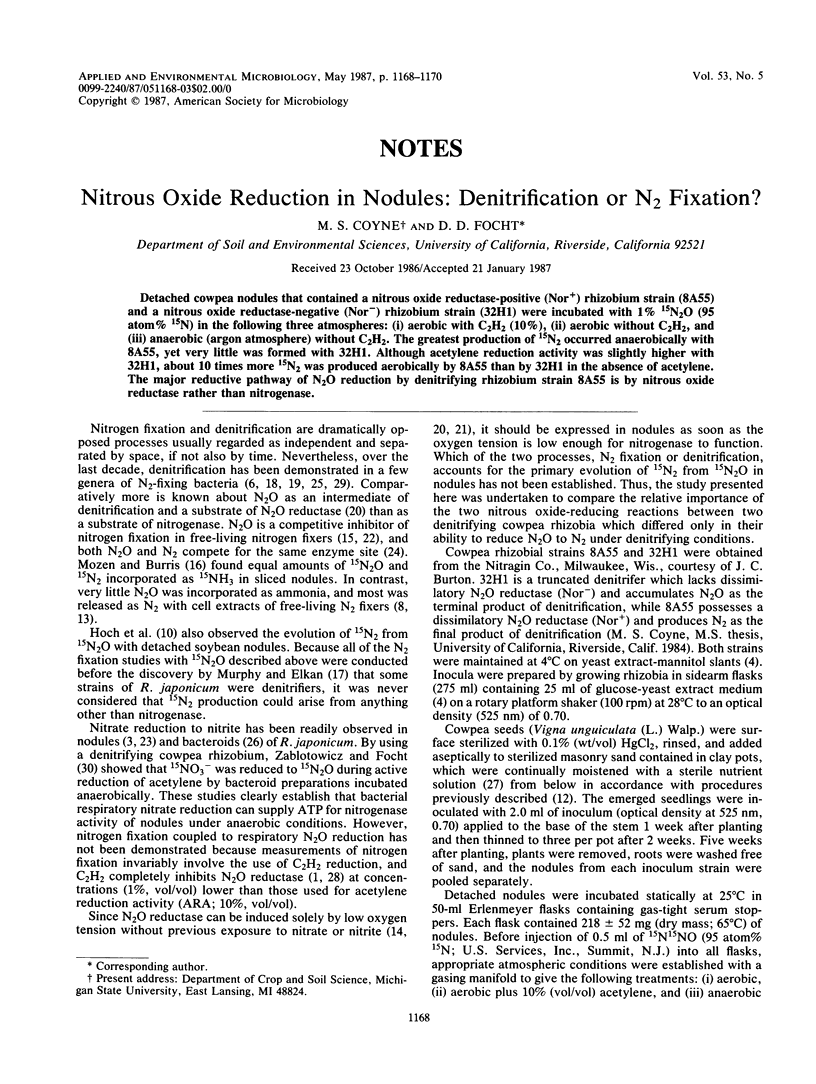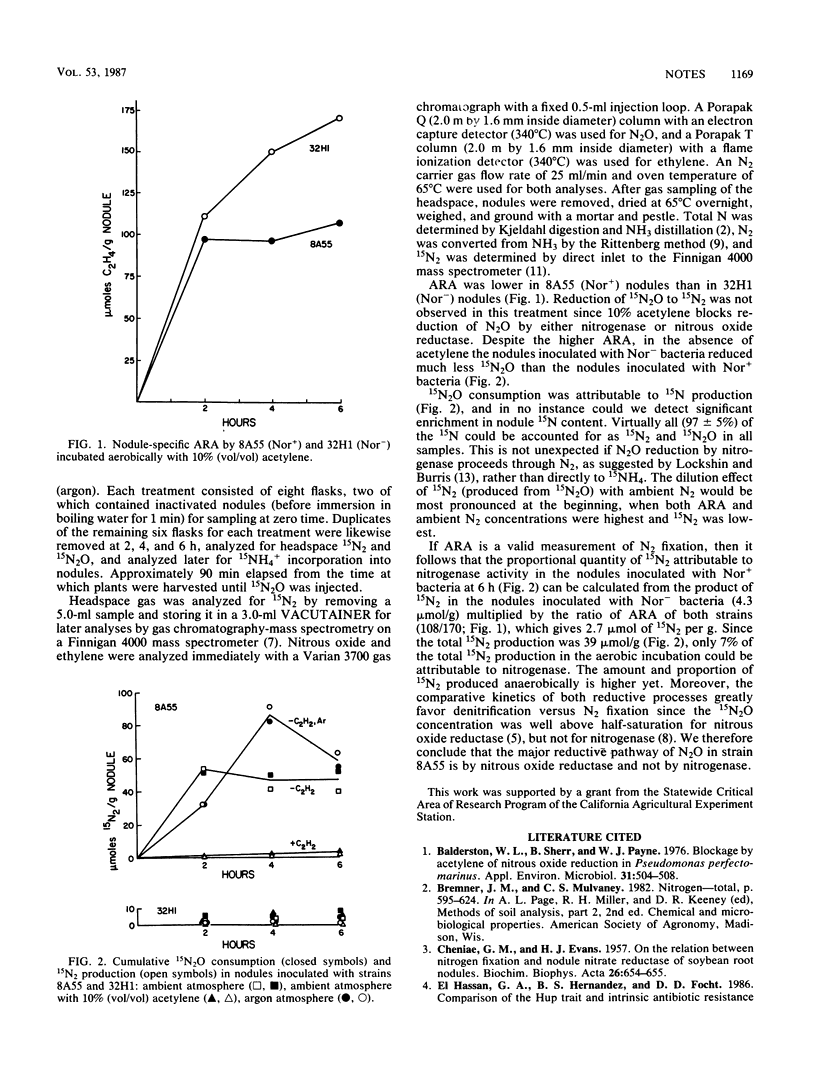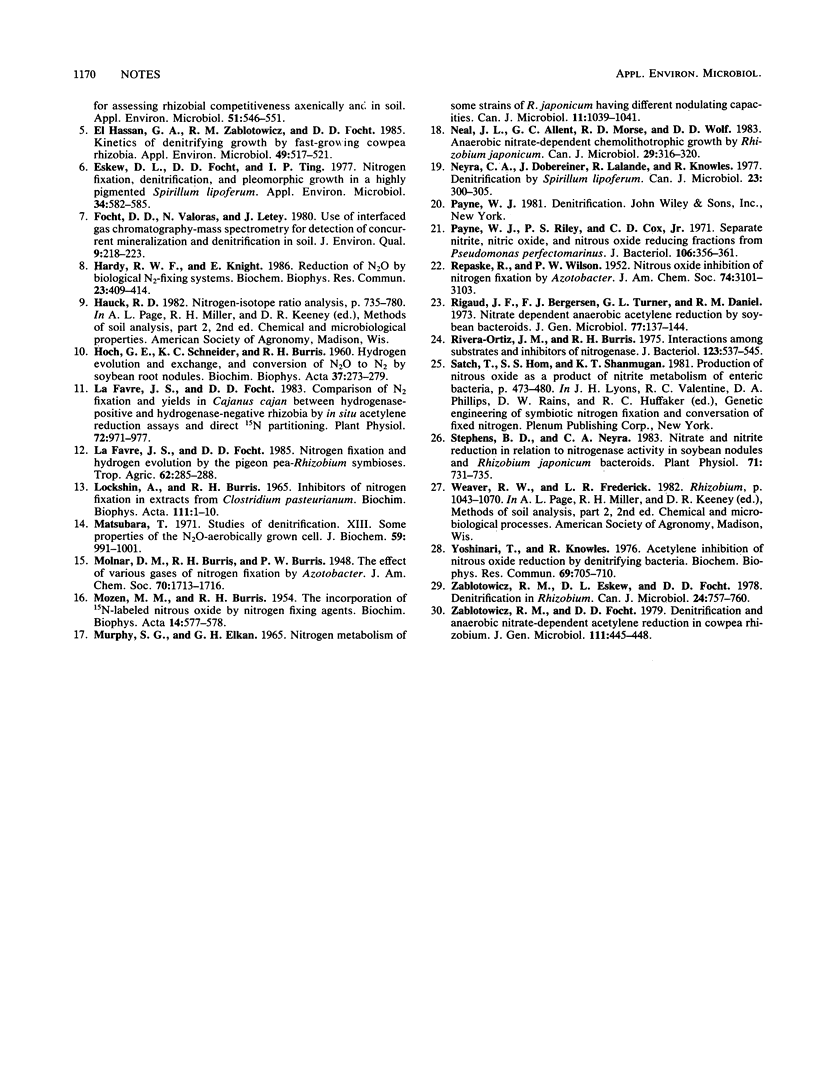Abstract
Detached cowpea nodules that contained a nitrous oxide reductase-positive (Nor+) rhizobium strain (8A55) and a nitrous oxide reductase-negative (Nor−) rhizobium strain (32H1) were incubated with 1% 15N2O (95 atom% 15N) in the following three atmospheres: (i) aerobic with C2H2 (10%), (ii) aerobic without C2H2, and (iii) anaerobic (argon atmosphere) without C2H2. The greatest production of 15N2 occurred anaerobically with 8A55, yet very little was formed with 32H1. Although acetylene reduction activity was slightly higher with 32H1, about 10 times more 15N2 was produced aerobically by 8A55 than by 32H1 in the absence of acetylene. The major reductive pathway of N2O reduction by denitrifying rhizobium strain 8A55 is by nitrous oxide reductase rather than nitrogenase.
Full text
PDF


Selected References
These references are in PubMed. This may not be the complete list of references from this article.
- Balderston W. L., Sherr B., Payne W. J. Blockage by acetylene of nitrous oxide reduction in Pseudomonas perfectomarinus. Appl Environ Microbiol. 1976 Apr;31(4):504–508. doi: 10.1128/aem.31.4.504-508.1976. [DOI] [PMC free article] [PubMed] [Google Scholar]
- CHENIAE G. M., EVANS H. L. On the relation between nitrogen fixation and nodule nitrate reductase of soybean root nodules. Biochim Biophys Acta. 1957 Dec;26(3):654–655. doi: 10.1016/0006-3002(57)90122-1. [DOI] [PubMed] [Google Scholar]
- El Hassan G. A., Zablotowicz R. M., Focht D. D. Kinetics of denitrifying growth by fast-growing cowpea rhizobia. Appl Environ Microbiol. 1985 Mar;49(3):517–521. doi: 10.1128/aem.49.3.517-521.1985. [DOI] [PMC free article] [PubMed] [Google Scholar]
- Eskew D. L., Focht D. D., Ting I. P. Nitrogen fixation, denitrification, and pleomorphic growth in a highly pigmented Spirillum lipoferum. Appl Environ Microbiol. 1977 Nov;34(5):582–585. doi: 10.1128/aem.34.5.582-585.1977. [DOI] [PMC free article] [PubMed] [Google Scholar]
- HOCH G. E., SCHNEIDER K. C., BURRIS R. H. Hydrogen evolution and exchange, and conversion of N2O to N2 by soybean root nodules. Biochim Biophys Acta. 1960 Jan 15;37:273–279. doi: 10.1016/0006-3002(60)90234-1. [DOI] [PubMed] [Google Scholar]
- Hardy R. W., Knight E., Jr Reduction of N2O by biological N2-fixing systems. Biochem Biophys Res Commun. 1966 May 25;23(4):409–414. doi: 10.1016/0006-291x(66)90742-x. [DOI] [PubMed] [Google Scholar]
- La Favre J. S., Focht D. D. Comparison of N(2) Fixation and Yields in Cajanus cajan between Hydrogenase-Positive and Hydrogenase-Negative Rhizobia by In Situ Acetylene Reduction Assays and Direct N Partitioning. Plant Physiol. 1983 Aug;72(4):971–977. doi: 10.1104/pp.72.4.971. [DOI] [PMC free article] [PubMed] [Google Scholar]
- Lockshin A., Burris R. H. Inhibitors of nitrogen fixation in extracts from Clostridium pasteurianum. Biochim Biophys Acta. 1965 Nov 15;111(1):1–10. doi: 10.1016/0304-4165(65)90466-6. [DOI] [PubMed] [Google Scholar]
- MOZEN M. M., BURRIS R. H. The incorporation of 15N-labelled nitrous oxide by nitrogen fixing agents. Biochim Biophys Acta. 1954 Aug;14(4):577–578. doi: 10.1016/0006-3002(54)90243-7. [DOI] [PubMed] [Google Scholar]
- Matsubara T. Studies on denitrification. 8. Some properties of the N2O-anaerobically grown cell. J Biochem. 1971 Jun;69(6):991–1001. doi: 10.1093/oxfordjournals.jbchem.a129572. [DOI] [PubMed] [Google Scholar]
- Murphy S. G., Elkan G. H. Nitrogen metabolism of some strains of Rhizobium japonicum having different nodulating capacities. Can J Microbiol. 1965 Dec;11(6):1039–1041. doi: 10.1139/m65-143. [DOI] [PubMed] [Google Scholar]
- Neyra C. A., Döbereiner J. Denitrification by N2-fixing Sprillum lipoferum. Can J Microbiol. 1977 Mar;23(3):300–305. doi: 10.1139/m77-044. [DOI] [PubMed] [Google Scholar]
- Payne W. J., Riley P. S., Cox C. D., Jr Separate nitrite, nitric oxide, and nitrous oxide reducing fractions from Pseudomonas perfectomarinus. J Bacteriol. 1971 May;106(2):356–361. doi: 10.1128/jb.106.2.356-361.1971. [DOI] [PMC free article] [PubMed] [Google Scholar]
- Rivera-Ortiz J. M., Burris R. H. Interactions among substrates and inhibitors of nitrogenase. J Bacteriol. 1975 Aug;123(2):537–545. doi: 10.1128/jb.123.2.537-545.1975. [DOI] [PMC free article] [PubMed] [Google Scholar]
- Stephens B. D., Neyra C. A. Nitrate and Nitrite Reduction in Relation to Nitrogenase Activity in Soybean Nodules and Rhizobium japonicum Bacteroids. Plant Physiol. 1983 Apr;71(4):731–735. doi: 10.1104/pp.71.4.731. [DOI] [PMC free article] [PubMed] [Google Scholar]
- Yoshinari T., Knowles R. Acetylene inhibition of nitrous oxide reduction by denitrifying bacteria. Biochem Biophys Res Commun. 1976 Apr 5;69(3):705–710. doi: 10.1016/0006-291x(76)90932-3. [DOI] [PubMed] [Google Scholar]
- Zablotowicz R. M., Eskew D. L., Focht D. D. Denitrification in Rhizobium. Can J Microbiol. 1978 Jun;24(6):757–760. doi: 10.1139/m78-126. [DOI] [PubMed] [Google Scholar]


